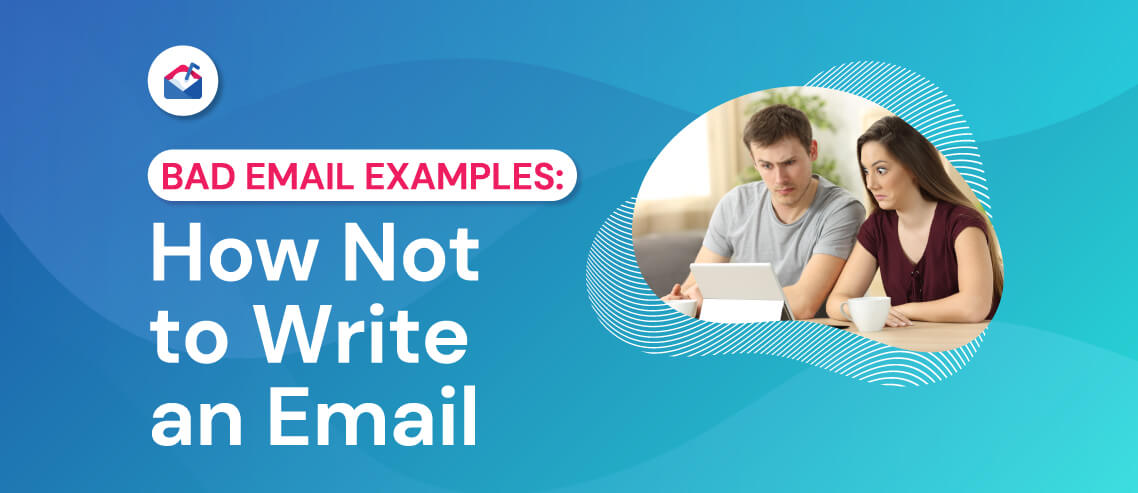10 Bad Email Examples: How Not to Write an Email

Contents
Cold emails are a powerful way to turn prospects into leads—if they’re done right. Writing a solid cold email isn’t easy, but by learning from these bad email examples, you’ll be on your way to higher open rates and more conversions.
Let’s look at ten examples of bad email communication—and some better alternatives—so you don’t make these cold email mistakes.
1. Lengthy subject lines
Using too many characters in your subject line makes it less likely that your email gets opened. Why? It’s simple—Gmail, one of the most popular email providers worldwide, will only display up to 70 characters. Keeping it below 70 characters is a must, but the shorter, the better; smartphones will only display around 40 characters on their screens.
Bad example:
Looking to automate your email outreach? It’s time to find a better sales engagement solution
Good example:
Automate your email outreach with the right sales engagement platform
2. Generic subject lines
Many marketers don’t personalize the subject lines of their emails, but using the prospect’s name increases the chance of them opening it. While adding that little touch of personalization isn’t a complete game-changer, it has enough of an impact that you might be losing out on leads by being too generic. It’s a simple, effective attention grabber that adds the element of human interaction.
Bad example:
Want to book a demo of Mailshake?
Good example:
Adam, want a demo of Mailshake?
3. No recipient name
If you’re sending out cold emails without addressing them to the right people, forget about getting a response. The last thing you want is for your email to get flagged as spam and blacklisted, which is exactly what will happen if you send out each email with a generic greeting. Addressing the person you want to reach by name is a way to establish an initial connection and keep their attention.
Bad example:
Hello!
Hope you are doing well.
Good example:
Hello Adam,
We heard about your . . .
4. Focusing on features rather than benefits
A common mistake when sending cold emails is to spend too much time talking about your product’s features. Here’s a better way that will keep your prospects interested: Highlight a particular problem that affects your target audience and inform them how your product or service can solve it for them. They aren’t interested so much in what your product can do, but what it can do for them.
Bad example:
Hello,
At Mailshake, we’ve created an email outreach automation program that does XYZ . . .
Good example:
Hello Adam,
Would you be interested in a way to automate your email outreach to fill your CRM with leads and connect with prospective customers through every channel?
5. Too friendly
Should you use a polite tone? Yes. Should you act like your prospect’s best friend? No. Flattery does work to an extent, but only when done tactfully. You should avoid inquiring about personal details, giving praise for trivial matters, and using their name multiple times throughout the email. All of these can make you come off as too friendly, which can make your prospect wary or uncomfortable.
Bad example:
Dear Adam,
I hope you’re doing great! How was your weekend? I heard you recently released a new product. Great job! By the way, Adam, are you the person responsible for purchasing software at your company?
Good example:
Hello Adam,
Are you responsible for making software purchases at Mailshake?
6. No clear call to action (CTA)
With a good subject line, you’ll see increased open rates. Once a prospect opens your email, the quality of your CTA directly affects your response rates. It’s the last impression you’ll leave on them. Without a clear, specific call to action, how is your prospect supposed to respond? They need a reason to click through and get to your landing page—that’s where your CTA comes in. Keep it specific and to the point.
Bad example:
Get in touch with us.
Good example:
Interested in generating consistent leads? Book your free demo of Mailshake and start increasing your leads, sales, and revenue today.
7. Too many CTAs
The only thing worse than not including a clear CTA is using too many. While it might be tempting to have a variety of CTAs throughout your email (they’ll click on at least one of them, right?), it’s more likely to confuse or annoy your prospect. Don’t overwhelm them—you should include a specific one in the email body and a second, more generic one in your email signature.
Bad example:
Follow us on Twitter
Increase your leads
Click here for a free trial
Click here for a product demo
Good example:
Get started with your free trial.
8. Grammar and spelling mistakes
An email with typos, spelling mistakes, or faulty grammar is a terrible way to begin a relationship with a prospect. It shows that you’re not serious about your email, your product, or them. That’s not the first impression you want to make. Simple errors indicate that the sender doesn’t care enough to double-check their work. Proofread your email before hitting send—it could mean the difference between getting a response or not.
Bad example:
Hey Adem,
i just wanted to reach out too you, and share this new tool that I thought might interst you.
Good example:
Hey Adam,
I wanted to reach out to you and share this new tool that I thought might interest you.
9. The “from” name
An easy way to increase your open rates and make better first impressions is by sending out your emails from a real person, not a generic company email. Think about when you receive an email—the two things you most likely notice first are the subject line and the sender’s name or address. Create a human connection between you and your prospect by showing them that a real person sent the email and they aren’t just part of a mass outreach.
Bad example:
From: Mailshake@Mailshake.com
Good example:
From: Adam Smith
Adam@Mailshake.com
10. The opening line
Bad emails start out with the sender’s name, company’s name, and what the company does. While some prospects may be interested in knowing those details, the real reason they’ll read your email is to see if you can provide them with something of value. Your opening line needs to catch the reader’s attention. Add a touch of personalization by assuring your prospect that you aren’t a random salesman taking a shot in the dark—show them that you’ve done some research and are knowledgeable about their company and field.
Bad example:
Hey Adam,
My name is John from GenericSEO, a leading digital marketing company. We’re so great because XYZ . . .
Good example:
Hey Adam,
I noticed that your site isn’t ranking for some keywords that could help you generate significantly more leads. Do you have a few minutes to talk?
Increase your open rates and generate more leads
Cold emailing is a solid sales technique. By avoiding the mistakes in these bad email examples and automating your outreach with a sales engagement platform like Mailshake, you’ll see an increase in your open and reply rates in no time.
Ready to avoid badly written emails and turn prospects into leads? Check out these cold email and sales email templates and get started with the free Cold Email Masterclass today.




